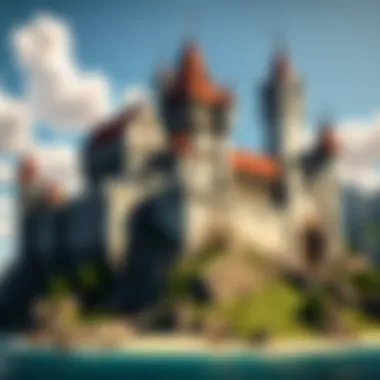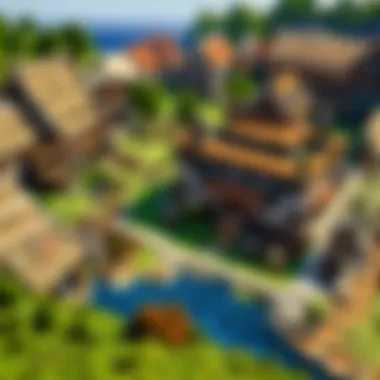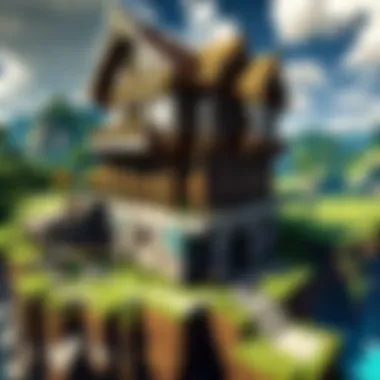Mastering Minecraft: Strategies and Techniques


Intro
Exploring the expansive world of Minecraft can feel like trying to drink from a fire hose. With its vast landscapes, limitless building opportunities, and a seemingly endless array of gameplay mechanics, it’s no wonder players often find themselves overwhelmed. Whether you're just starting your blocky journey or are a seasoned veteran looking to refine your skills, understanding the nuances of this cultural phenomenon is key. This guide will cover the essentials and the intricate workings of Minecraft, helping you navigate through the game with ease.
Minecraft Game Guides
Character Creation Guide
Creating your avatar in Minecraft is the first step toward embarking on your grand adventure. While it might seem simple, choosing how you look can reflect your gaming style. Before diving in, consider your character's skin. You can opt for the classic Steve or Alex skins, or you can upload custom designs to showcase your personality. After all, there's no need to walk around like a generic figure when you can flaunt a flashy costume!
Building Techniques Tutorial
When it comes to construction, building techniques can make all the difference. Mastering basic shapes is essential, but going further involves understanding proportion, scale, and even aesthetics. For example, using contrasting materials can add depth and interest to your structures. Also, employ tricks like layering and integrating landscaping for added realism.
- Basic Shapes: Start with cubes, pyramids, and walls.
- Advanced Techniques: Experiment with curves using stairs and slabs.
- Decoration: Furnish interiors and exteriors creatively utilizing items like banners, flowers, and paintings.
A great way to approach a new building project is sketching out your ideas on paper beforehand. This helps clarify your vision instead of making it up as you go along, which can often lead to messy results, and no one wants that!
Redstone Mechanics Explained
Redstone is the equivalent of electrical wiring in Minecraft, enabling players to build intricate machines and contraptions. Understanding how redstone works opens up endless possibilities—from simple doors that open with a pressure plate to complex calculators and traps. Here are some fundamental components to get you started:
- Redstone Dust: Used to connect various components.
- Levers and Buttons: They serve as inputs triggering actions.
- Pistons: These can push blocks or create moving parts in your designs.
Getting comfortable with redstone takes time and patience. Don’t hesitate to dabble in trial and error, as many advanced players started from the same point of confusion!
Crafting Recipes Encyclopedia
Crafting is the lifeblood of Minecraft. A deep understanding of crafting recipes can elevate your gameplay significantly. Here’s a quick rundown of some essential recipes every player should know:
- Tools: Pickaxes, axes, and shovels are fundamental for resource gathering.
- Weapons: Swords and bows will keep you safe in dark caves and during encounters.
- Armor: Crafting armor from various materials can protect you from hostile mobs.
Each material has unique properties and applications, so explore alternatives. For example, diamond gear is great, but leather armor can prove useful early in the game!
Latest Updates and Patch Notes
Keeping up with Minecraft's ever-evolving landscape is vital for maintaining a competitive edge. New updates can introduce significant changes to gameplay, adding fresh content or refining existing mechanics.
Patch Note Breakdown
Each patch brings its share of enhancements and fixes. Players should routinely check the official patch notes to grasp how gameplay dynamics might shift. A solid understanding of these changes allows players to adapt their strategies accordingly, which can make a world of difference in performance.
New Features Analysis
New features often come with updates, offering exciting gameplay mechanics. Whether it's the introduction of lush biomes or additional mobs, players need to familiarize themselves with these additions. It’s also helpful to join communities where feature analysis and discussions thrive—sites like Reddit provide daily insights and tips from fellow players.
Community Speculations and Theories
The Minecraft community is known for its wild speculations about future updates and features. Following these discussions can lead you to some interesting ideas and potential strategies for adapting your gameplay. Theories often pop up in forums and social media channels, so it’s wise to stay engaged.
"Minecraft is not just a game; it's a world of creativity and endless exploration!"
Mod Reviews and Recommendations
Mods can significantly enhance the Minecraft experience, offering new features, gameplay changes, and aesthetic improvements. Understanding which mods cater to your playstyle is crucial.


Top Mods of the Month
Every month, a slew of mods make waves in the community. Keeping abreast of these can be immensely rewarding. Join forums or check out streams to see which mods are making an impact.
Mod Spotlight Series
Spotlight features often dive deep into specific mods, offering a glimpse into their mechanics and functionalities. If you're considering a mod, this can highlight both pros and cons effectively.
Mod Installation Guides
For newcomers, installing mods can feel like uncharted territory. A solid guide is invaluable. Most mod authors provide installation instructions, so always read through them carefully before proceeding.
Minecraft News and Developments
Staying informed about Minecraft's place in the gaming industry is as important as mastering the game itself.
Industry News and Trends
Regularly check sites like en.wikipedia.org and britannica.com that cover gaming news to keep up-to-date with how Minecraft is evolving within the broader gaming landscape.
Behind-the-Scenes of Updates
Occasionally, developers share insights into the design process through interviews and blogs, which can be fascinating for those who want to understand the hard work behind their favorite game.
Upcoming Features and Sneak Peeks
Following reputable Minecraft news sources can offer glimpses into what might be coming next, allowing you to prepare and stay ahead of the curve.
Preface to Minecraft
Minecraft isn't just any game; it's a phenomenon that has planted roots in gaming culture and beyond. Its open-ended nature provides players with a canvas to create, explore, and strategize. This introductory section serves as a foundation for understanding how Minecraft works and why it matters in today's digital landscape. By uncovering the game's development and the social tapestry that surrounds it, players can better appreciate their experiences.
The Development Journey
Minecraft began as a simple concept, born out of Markus Persson's desire to blend survival and creation. Officially released in 2011, the game has seen numerous updates that refine its mechanics and expand its world. Each update often introduces new elements, tools, and creatures, ensuring that players remain engaged. This constant evolution is akin to adding fresh paint to a timeless masterpiece.
The game started as a humble indie project, showcasing how community feedback can enhance a product. The growth of Minecraft is an example of how iterative development, fueled by player input, can lead to staggering success. As players shaped the game through their critiques and ideas, Minecraft transformed into a collaborative effort, solidifying its status as a landmark in video game history.
Understanding the Player Base
The Minecraft community is a vibrant mosaic of players from all walks of life. Ranging from casual builders to seasoned survivalists, each player brings their unique flavor to the game. This diversity is one of the game's strengths. Understanding this player base is important because it directly influences how the game evolves and the types of experiences available.
Many players are drawn to the creative aspect, utilizing Minecraft as a tool for self-expression. They build intricate structures, landscapes, and entire worlds, turning their visions into reality. Others revel in the competitive environment, diving into survival mode where crafting and resource management becomes the name of the game.
Communities form on various platforms like Reddit and Facebook, where players share tips, tricks, and tutorials. These interactions foster a sense of camaraderie as players come together to discuss strategies or showcase their masterpieces. According to Wikipedia, Minecraft has become not only a significant source of entertainment but also an educational tool, used in classrooms around the world.
In summary, Minecraft isn't merely a game; it’s an ever-evolving universe that thrives on community engagement and creativity. The development journey has shaped it into what it is today, while the diverse player base continuously influences its future.
Core Gameplay Mechanics
Understanding the core gameplay mechanics of Minecraft is like getting to the heart of the beast. Familiarity with these systems not only elevates your competitiveness but also enriches your overall experience in the game. Each mechanic interlocks with others, crafting an intricately woven tapestry of possibilities, ensuring that every moment spent in this digital world can be rewarding and often surprising.
Game Modes Explained
Survival Mode
Survival Mode is where the adventure begins. Players must gather resources, construct shelters, and fend off hostile mobs, putting their creativity and strategic thinking to the test. One of the key characteristics that makes Survival Mode a popular choice is the thrill of advancement and achievement. The unique feature here is the health and hunger meters, demanding that players find food and health supplies while navigating the blocky landscape.


While players might relish the challenges, the constant need to manage resources and fend off dangers can also become overwhelming. Engaging in cooperative gameplay can mitigate some of these pressures, enhancing teamwork and strategy.
Creative Mode
In Creative Mode, players are handed a toolbox brimming with infinite resources, allowing them to let imagination take flight without the shackles of survival. This mode emphasizes creativity over survival skills. The key characteristic here is freedom; you can build towering castles, intricate statues, or sprawling cities without the worry of health or hunger.
The unique upside is the ability to fly, making construction easier. However, some might argue that this mode lacks the challenge, leading players to miss the adrenaline rush that comes from fighting mobs or building under the threat of the night. That said, it remains a sanctuary for both experienced builders and newcomers wishing to express their creativity without constraints.
Adventure Mode
Adventure Mode presents a hybrid of the two previous modes. It enables players to experience custom maps and adventures created by others while adhering to specific gameplay rules. One essential aspect of Adventure Mode is the ability to interact with blocks only in certain ways. This restriction helps to maintain the integrity of complex maps and challenges.
What makes Adventure Mode beneficial is its focus on storytelling and exploration. Players often find themselves immersed in narratives that captivate their attention. However, the constraining mechanics can frustrate those who prefer a more open-ended experience.
Spectator Mode
Spectator Mode offers a unique lens through which to observe the game world without directly interacting with it. Players can float around, fly through blocks, and experience the game from various perspectives. This mode's key characteristic is the freedom of exploration. It's mostly beneficial for players wanting to admire others’ creations or learn from more seasoned players without interrupting their gameplay.
What sets it apart is that there's no survival aspect to it, which can be both a pro and con. It's fantastic for observation but can leave players feeling detached from the action.
The Importance of Resource Management
Resource management is the backbone of progression in Minecraft. Mastering this aspect can be the difference between thriving and simply surviving.
Mining Techniques
Mining efficiently is an essential skill in Minecraft. It allows players to gather vital resources like ores, stones, and other materials necessary for construction and crafting. Key techniques center around ore location strategies and depth considerations, making mining a strategic process.
The uniqueness of dividing your mining into narrow tunnels can lead to better ore retrieval odds. But players need to be cautious; mining too deep or carelessly can lead to disasters like lava encounters or phantom attacks. Knowing when and where to mine can significantly enhance your game without facing unnecessary risks.
Crafting Essentials
Crafting is at the very heart of what makes Minecraft engaging. It allows players to transform raw materials into tools, equipment, and buildings. Learning the crafting recipes is an essential part of gameplay, enabling players to adapt and build according to needs.
One critical characteristic of crafting is its versatility. Players can experiment, producing everything from simple tools to complex contraptions. However, the learning curve can be steep, especially for newcomers navigating the variety of recipes and their uses. The joy of successfully creating items, however, often outweighs the initial struggle.
Inventory Optimization
Managing your inventory is crucial in ensuring you’re always equipped for whatever Minecraft throws your way. Efficient inventory optimization can involve organizing items logically, reducing clutter, and prioritizing important resources like food and building materials.
An important aspect of this is crafting dedicated chests for specific materials, which can save time during chaotic encounters. However, players might find themselves filling their inventory too quickly if they don’t manage it well, leading to wasted resources. Striking a balance between collection and organization can enhance the gameplay experience immensely.
Advanced Gameplay Strategies
In the expansive universe of Minecraft, mastering advanced gameplay strategies can significantly enhance your experience. Not only do these strategies pave the way to more efficient resource gathering and building, but they also elevate your overall enjoyment of the game. The focus here is on a nuanced approach to building structures and exploring new terrains. By effectively utilizing technical elements and understanding the environment, players can adapt their tactics and emerge victorious in their endeavors. This section shines a light on the art of construction and the intricacies of exploration, ensuring you're not just playing the game, but truly mastering it.
Building Efficient Structures
Architectural Styles
Architectural styles in Minecraft offer players a remarkable opportunity to express creativity while ensuring efficient space utilization. Choosing the right style can drastically influence the aesthetics and functionality of a build. For instance, combining medieval designs with modern elements can create something unique and engaging for the eye.
A key characteristic of architectural styles is their adaptability. Players can easily mix and match different styles to suit their in-game environment or personal taste. A popular choice, the modern style, emphasizes sleek lines and minimalism, which can lead to a faster construction process and lesser resource consumption. However, one needs to consider that simplicity might not always resonate with every player, depending on their artistic intent.
In addition, every style comes with its own set of unique features. Gothic builds, with their tall towers and intricate detailing, demand substantial resources and time. Though such structures could serve as landmarks in a multiplayer setting, they usually require a more considerable commitment from the builder, which could discourage some players.
Redstone Mechanisms


The significance of Redstone mechanisms in Minecraft cannot be overstated. These allow players to create complex contraptions and automate tasks, thus streamlining gameplay. Utilizing Redstone can transform mundane processes into something extraordinary, such as building hidden doors, automatic farms, and even mini-games.
A prominent feature of Redstone is its circuitry system. This complexity can be daunting at first but gives ample room for creativity and innovation. Mastering this aspect provides an opportunity for players to showcase their ingenuity in design and functionality. However, it requires a solid understanding of the game to achieve optimal results.
Yet, Redstone isn’t without its downsides. The learning curve can be steep, and players may find themselves frustrated if they are new to wiring and timing mechanisms. For some, this complexity can both excite and intimidate, making it vital to balance functionality with personal gameplay style.
Defensive Structures
In a multiplayer environment, the importance of defensive structures becomes apparent as players strive to protect their hard-earned resources and creations. These structures serve as barriers between the player and various threats, including hostile mobs and other players looking to raid or destroy.
The key characteristic of defensive structures is their versatility. Players can choose to build walls, towers, and fortresses that cater to their strategy and surroundings. A well-constructed fortress, for instance, can turn the tides in your favor during PvP battles or mob attacks.
One unique feature of these structures is the ability to integrate traps. Traps can deter enemies and provide additional layers of defense, making your stronghold nearly impenetrable. However, it’s essential to remember that creating complex defense systems might sap valuable resources and time, which could be used elsewhere, presenting a clear trade-off for players to consider.
Exploration Techniques
Biomes and Their Resource Potential
Biomes in Minecraft provide diverse environments, each hosting unique resources that are essential for survival and progression. Understanding the characteristics of different biomes is crucial for any adventurous player wishing to optimize their resource-gathering efforts.
Each biome is distinct and offers its own set of raw materials. For example, deserts are abundant in sand while forests provide ample wood. This specialization makes it vital for players to venture across biomes to collect resources efficiently. Notably, players can also encounter rare structures like villages or temples, which can further enhance their inventory.
Yet, as beneficial as these environments are, they also come with disadvantages. Some biomes may pose significant challenges, such as extreme temperatures or hostile mobs. It becomes a balancing act of risk and reward, and players need to be prepared for challenges along their journeys.
Village Interaction
Interacting with villages can significantly propel your gameplay, providing resources, trading opportunities, and even potential allies in difficult times. Villages often host various NPCs that offer goods and items that can be vital to your survival. The exchange system encourages players to engage more actively with their environment.
The key characteristic of village interaction is that it opens up pathways for trading. Players can barter resources they do not need for items that can help in their crafting or building endeavors. This dynamic makes exploring villages all the more appealing.
However, one potential drawback is that the availability and quality of trades can vary widely among villages. A poorly stocked village may hinder progress, while a treasure-filled one can spur rapid advancement, which adds an unpredictable element to this interaction.
Nether and End Dimensions
The Nether and End Dimensions provide unique gameplay experiences and are a treasure trove of resources that can advance your journey significantly. These realms are often deemed more challenging due to the hostile environment and formidable foes.
A defining characteristic of these dimensions is the abundance of unique materials, like Nether Quartz and Ender Pearls. Players venturing into the Nether can harvest powerful resources crucial for crafting potions and building beacons, while the End is home to the mighty Ender Dragon and valuable End stone. This makes both locations crucial for players looking to enhance their capabilities further.
Yet, they are not without dangers. The hostile mobs and treacherous terrain of these dimensions mean that players must be well-prepared and strategize effectively. The lure of rare resources must be weighed against the risks involved in exploration, rendering careful planning essential.
Multiplayer Dynamics
The world of Minecraft is not just about blocks and building; it thrives on the interactions between players. Multiplayer dynamics enhance the experience, creating a shared environment where creativity and competition can flourish. Players of all ages benefit from these dynamics as they engage with one another, exchanging ideas, resources, and experiences. Whether it's cooperating in a survival challenge or pitting skills against one another, the multiplayer element adds depth that single-player mode lacks.
Server Structures and Communities
Types of Servers
Understanding the various types of servers can significantly enhance the Minecraft experience. Servers typically fall into categories like survival, creative, factions, and minigames.
- Survival Servers: Players must gather resources, fend off mobs, and build shelters. This type remains popular for its challenging balance of construction and combat.
- Creative Servers: Here, imagination knows no bounds. Players can fly, access all blocks, and build grandiose structures with ease, often collaborating on massive projects.
- Factions Servers: These are competitive environments where players form alliances to conquer others. The strategic element appeals to those who thrive on PvP (player vs. player).
- Minigames Servers: They offer various mini-challenges, from parkour to races, perfect for quick gameplay that breaks up longer sessions.
Each type has unique characteristics that cater to different playstyles, ensuring there is something for everyone. For instance, survival servers promote resource management skills, while creative servers focus purely on artistic freedom.
Community Engagement and Events
Community plays a crucial role in shaping the Minecraft experience. Engagement events such as build contests, treasure hunts, and seasonal celebrations foster a sense of belonging. The camaraderie formed during these activities not only enhances player interaction but helps nurture friendships that extend beyond the game.
- Unique Features of Events: These often include challenging tasks that bring players together, offering rewards or recognition for their efforts. They can inspire creativity, as players showcase their builds or collaborate on supports.
- Advantages: Active engagement keeps players returning. A strong, inclusive community increases server loyalty and contributes to a vibrant server culture. Events can also attract new players, turning casual visitors into dedicated participants.
Community events are not just a way to have fun; they strengthen the bonds between players, transforming a simple game into a shared adventure.



